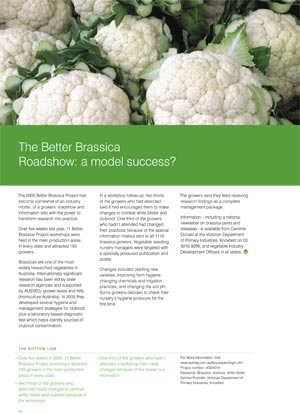|
|
The 2005 Better Brassica Project has The Brassica industry has made significant investment into researching pest and disease issues faced by the industry. A few years have elapsed since some of these projects finished. Results of this research are highly sought after but have not always been easy to access particularly if the project has been completed. The better brassicas project was designed to collate and deliver the most up to date information from current and recently completed disease management projects.
There were many advantages to a coordinated approach to delivery of R&D outcomes including: economies of scale, grower willingness to participate and the elimination of state bias in information delivery. While the workshops did not reach all growers, those that attended were overwhelmingly positive in their feedback about the workshops. High quality supplemental publications would be needed to compliment these events because workshops are only ever going to be attended by a proportion of the industry. Over five weeks, 11 Better Evaluation interviews 6 months later, showed two thirds One third of the growers Vegetable seedling Changes included planting new Some growers decided to check their This project was facilitated by HAL in partnership with AUSVEG and was funded by the National Vegetable levy. The Australian Government provides matched funding for all HAL’s R&D activities. |
|

